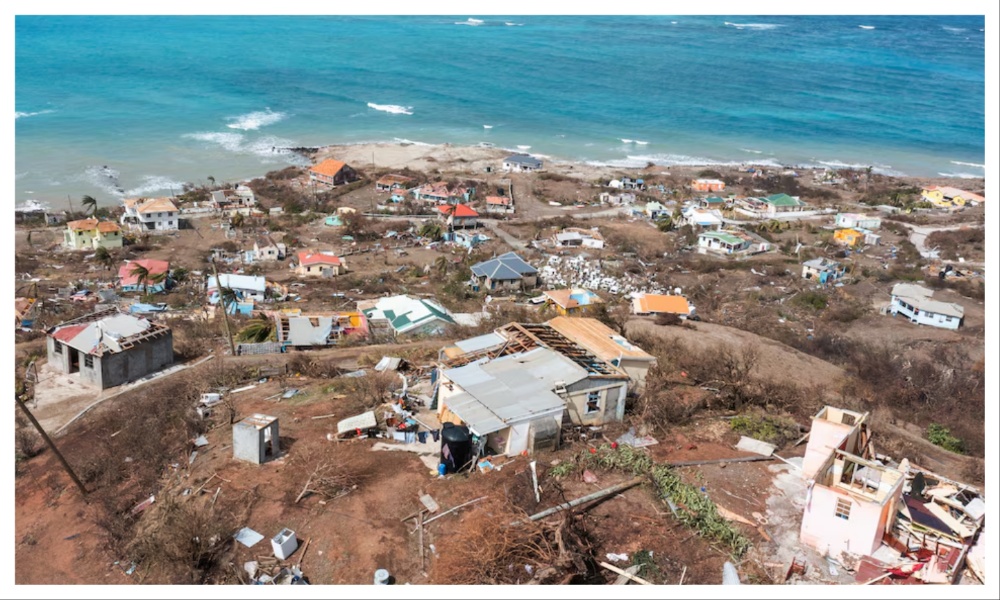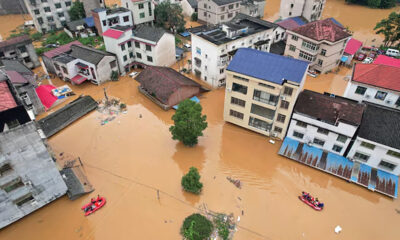Climate Change
Prince William meets President Biden in Boston to discuss climate change

Prince William greeted US President Joe Biden at the waterfront in Boston on Friday, part of a three-day visit by British royals trying to focus attention on tackling environmental issues.
William and his wife, Kate, attempted to keep the spotlight on climate and other causes they champion on their first overseas trip since taking on the titles of Prince and Princess of Wales after the death of Queen Elizabeth in September.
In the middle of their US visit, however, Netflix Inc released a trailer for an upcoming documentary series about William’s younger brother, Harry, and his American wife, Meghan, reviving talk about rifts in the royal family. Buckingham Palace also was dealing with a new racism controversy, Reuters reported.
On Friday afternoon, William smiled as he met Biden outdoors in cold weather along Boston’s waterfront. The two men took a brief stroll before a private meeting at the John F. Kennedy Presidential Library and Museum.
The pair were expected to discuss “shared climate goals” and “prioritization of mental health issues,” White House spokeswoman Karine Jean-Pierre told reporters before the meeting.
Later on Friday, William and Kate were due to honor winners of the Earthshot Prize, an award William established to recognize people working to fight the effects of climate change. Grammy-winning singer Billie Eilish and others were scheduled to perform at the star-studded ceremony.
“We want to demonstrate what we can all do to help put the world on a path towards a stable climate, where communities, nature and oceans thrive in harmony,” William said in an opinion piece published in The Huffington Post on Friday.
Kate and William last visited the United States in 2014, when they were guests of then-President Barack Obama at the White House.
Climate Change
2024 could be world’s hottest year as June breaks records
Greenhouse gas emissions from burning fossil fuels are the main cause of climate change.

Last month was the hottest June on record, the EU’s climate change monitoring service said on Monday, continuing a streak of exceptional temperatures that some scientists said puts 2024 on track to be the world’s hottest recorded year.
Every month since June 2023 – 13 months in a row – has ranked as the planet’s hottest since records began, compared with the corresponding month in previous years, the European Union’s Copernicus Climate Change Service (C3S) said in a monthly bulletin.
The latest data suggest 2024 could outrank 2023 as the hottest year since records began after human-caused climate change and the El Nino natural weather phenomenon both pushed temperatures to record highs in the year so far, some scientists said.
“I now estimate that there is an approximately 95% chance that 2024 beats 2023 to be the warmest year since global surface temperature records began in the mid-1800s,” said Zeke Hausfather, a research scientist at U.S. non-profit Berkeley Earth.
The changed climate has already unleashed disastrous consequences around the world in 2024.
More than 1,000 people died in fierce heat during the haj pilgrimage last month. Heat deaths were recorded in New Dehli, which endured an unprecedentedly long heatwave, and amongst tourists in Greece.
Friederike Otto, a climate scientist at Imperial College London’s Grantham Institute, said there was a “high chance” 2024 would rank as the hottest year on record.
“El Nino is a naturally occurring phenomenon that will always come and go. We can’t stop El Nino, but we can stop burning oil, gas, and coal,” she said.
The natural El Nino phenomenon, which warms the surface waters in the eastern Pacific Ocean, tends to raise global average temperatures.
That effect subsided in recent months, with the world now in neutral conditions before cooler La Nina conditions are expected to form later this year.
C3S’ dataset goes back to 1940, which the scientists cross-checked with other data to confirm that last month was the hottest June since the 1850-1900 pre-industrial period.
Greenhouse gas emissions from burning fossil fuels are the main cause of climate change.
Despite promises to curb global warming, countries have so far failed collectively to reduce these emissions, pushing temperatures steadily higher for decades.
In the 12 months ending in June, the world’s average temperature was the highest on record for any such period, at 1.64 degrees Celsius above the pre-industrial average, C3S said. – Reuters
Climate Change
Heavy rains trigger landslides in Nepal, 11 killed, 8 missing
Authorities said the flows of Narayani, Rapti and Mahakali rivers in the west were also rising.

Heavy rains triggered landslides and flash floods killing at least 11 people in the last 36 hours in Nepal and blocking key highways and roads, officials said on Sunday.
Eight people were missing, either washed away by floods or buried in landslides, while 12 others were injured and being treated in hospitals, police spokesperson Dan Bahadur Karki said, Reuters reported.
“Rescue workers are trying to clear the landslides and open the roads,” Karki told Reuters, adding heavy equipment was being used to clear debris.
In southeastern Nepal, the Koshi River, which causes deadly floods in the eastern Indian state of Bihar almost every year, was flowing above the danger level, a district official said.
“The flow of Koshi is rising and we have asked residents to remain alert about possible floods,” Bed Raj Phuyal, a senior official of Sunsari district where the river flows, told Reuters.
He said at 0900 hours (0315 hours GMT) water flow in Koshi River was 369,000 cusecs per second, more than double its normal flow of 150,000 cusecs.
Cusec is the measurement of the flow of water and one cusec is equal to one cubic foot per second.
Authorities said all 56 sluice gates of the Koshi Barrage had been opened to drain out water compared with about 10-12 during a normal situation.
Authorities said the flows of Narayani, Rapti and Mahakali rivers in the west were also rising.
In hill-ringed Kathmandu, several rivers have overflown their banks, flooded roads and inundated many houses.
Local media showed people wading through waist-deep water or residents using buckets to empty their houses.
At least 50 people across Nepal have died in landslides, floods and lightning strikes since mid-June when annual monsoon rains started.
Hundreds of people die every year in landslides and flash floods that are common in mostly mountainous Nepal during the monsoon season which normally starts in mid-June and continues through mid-September.
In the northeastern Indian state of Assam, floods have killed dozens and displaced thousands of people in the past few days.
Climate Change
Hurricane Beryl strikes Jamaica as Caymans, Mexico brace for storm’s impact
The death toll from the powerful Category 4 hurricane climbed to at least 10, but it is widely expected to rise further as communications come back online across drenched islands

Hurricane Beryl thrashed Jamaica with heavy winds and rain on Wednesday, killing at least one person after forging a destructive, water-soaked path across smaller Caribbean islands over the past couple of days.
The death toll from the powerful Category 4 hurricane climbed to at least 10, but it is widely expected to rise further as communications come back online across drenched islands damaged by flooding and deadly winds, Reuters reported.
In Jamaica, Beryl’s eyewall skirted the island’s southern coast, pummeling communities as emergency groups rushed to evacuate people from flood-prone areas.
“It’s terrible. Everything’s gone. I’m in my house and scared,” said Amoy Wellington, a 51-year-old cashier who lives in Top Hill, a rural farming community in Jamaica’s southern St. Elizabeth parish. “It’s a disaster.”

A man walks near damaged vehicles after devastating floods swept through the town after Hurricane Beryl passed off the Venezuelan coast, in Cumanacoa, Venezuela. Photo: REUTERS
A woman died in Jamaica’s Hanover parish after a tree fell on her home, Richard Thompson, acting director general at Jamaica’s disaster agency said in an interview on local news.
Nearly a thousand Jamaicans were in shelters by Wednesday evening, Thompson added.
The island’s main airports were closed and streets were mostly empty after Prime Minister Andrew Holness issued a nationwide curfew for Wednesday.
“We can do as much as we can do, as (is) humanly possible, and we leave the rest in the hands of God,” Holness said earlier on Wednesday, urging residents in vulnerable areas to evacuate.
The loss of life and damage wrought by Beryl underscores the consequences of a warmer Atlantic Ocean, which scientists cite as a telltale sign of human-caused climate change fueling extreme weather that differs from past experience.
Ralph Gonsalves, prime minister of St. Vincent and the Grenadines, one of the hardest-hit areas in the eastern Caribbean, said in a radio interview that the country’s Union Island was “flattened” by Beryl.
“Everybody is homeless … It is going to be a Herculean effort to rebuild.”

Scattered debris and houses with missing roofs are seen in a drone photograph after Hurricane Beryl passed the island of Petite Martinique, Grenada. Photo: REUTERS
Speaking to state media, Nerissa Gittens-McMillan, permanent secretary at St. Vincent and the Grenadines’ agriculture ministry, warned of possible food shortages after 50% of the country’s plantain and banana crops were lost, with significant losses also to root crops and vegetables, Reuters reported.
Power outages were widespread across Jamaica, while some roads near the coast were washed out.
By Wednesday evening, the eye of the spiraling hurricane was located about 161 km west of Kingston, according to the U.S. National Hurricane Center (NHC), as the storm’s core headed toward the Cayman Islands, where hurricane conditions were expected late tonight.
Beryl is packing maximum sustained winds of over 200 kilometers per hour.
RELATED STORIES
Afghanistan a victim of climate change, says Muttaqi
Heat wave kills at least 56 in India, nearly 25,000 heat stroke cases, from March-May
-

 Sport4 days ago
Sport4 days agoOlympics finally here; What you need to know
-

 Latest News5 days ago
Latest News5 days agoOCHA reports 110 die in landmine explosions in Afghanistan every month
-

 Regional5 days ago
Regional5 days agoChina braces for twin tropical cyclones after deadly flash floods
-

 Health4 days ago
Health4 days agoHealth partners provide services 589,205 people in Afghanistan in last month
-

 Latest News4 days ago
Latest News4 days agoAfghanistan’s Hajj ministry confirms death of 27 pilgrims in Mecca and Medina
-

 Business5 days ago
Business5 days agoConference on Islamic microfinance kicks off in Kabul
-

 Sport4 days ago
Sport4 days agoACB proposes ODI fixtures against top-tiered teams
-

 Latest News4 days ago
Latest News4 days agoIslamabad claims three terrorists killed at Pakistan-Afghanistan border



























